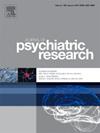简易自杀认知量表对住院、门诊、急诊科高危病人临床样本的临床应用
IF 3.2
2区 医学
Q1 PSYCHIATRY
引用次数: 0
摘要
本研究探讨了简易自杀认知量表(B-SCS)在多个样本中的临床应用,包括一个标准样本和三个不同自杀风险程度的临床样本。在住院患者随机临床试验(RCT)样本、急诊科(ED)样本和连续住院患者样本中,得出的切割评分是相同的,在入院时的B-SCS评分分别正确预测了RCT和ED样本中96%和94%的6个月随访期间的自杀企图。此外,在六个月的随访期间,RCT样本中的B-SCS摄入得分预测了高自杀意念组和低自杀意念组的差异,在整个出院后随访期间,低于B-SCS摄入截止得分的患者报告的自杀意念得分在正常范围内。目前的研究结果支持这样的建议,即根据具体的临床环境和相关的临床决策,评估识别自杀风险的仪器的临床效用需要不同的标准。对于出院后的监测以及针对住院和急诊科临床环境的相关治疗,具有高灵敏度和高负预测价值(NPV)估计的仪器尤其重要,因为需要准确识别急性发作的自杀风险的解决方案,并识别未来发作的易感者。在目前的研究中,B-SCS的敏感性估计为。96和。94和净现值估计为。97和93。在这些临床环境中。讨论了对日常实践的影响、未来研究的需要和研究的局限性。本文章由计算机程序翻译,如有差异,请以英文原文为准。
Clinical utility of the brief suicide cognitions scale with high-risk inpatient, outpatient, and emergency department clinical samples
The current study explored the clinical utility of the Brief Suicide Cognitions Scale (B-SCS) in multiple samples, including a normative sample and three clinical samples with varying degrees of suicide risk. Derived cutting scores were identical across an inpatient randomized clinical trial (RCT) sample, an emergency department (ED) sample, and an inpatient consecutive admission sample, with B-SCS scores at intake correctly predicting 96 % and 94 % of suicide attempts over six-month follow-up periods in the RCT and ED samples, respectively. Additionally, the B-SCS intake scores in the RCT sample predicted differences in high and low suicide ideation groups over the six-month follow-up period, with those below the B-SCS intake cutoff score reporting suicidal ideation scores within normal limits throughout the entirety of post-discharge follow-up. Current results support the recommendation that evaluation of the clinical utility of instruments identifying suicide risk require variable criteria depending on the specific clinical context and related clinical decision-making. With respect to post-discharge monitoring and related treatment tailoring for inpatient and ED clinical environments, instruments with strong sensitivity and high negative predictive value (NPV) estimates are of particular importance given the need to accurately recognize both the resolution of an acute episode of suicide risk and identify those vulnerable for future episodes. In the current study, the B-SCS had sensitivity estimates of .96 and .94 and NPV estimates of .97 and .93. in these clinical settings. Implications for day-to-day practice, the need for future research, and study limitations are discussed.
求助全文
通过发布文献求助,成功后即可免费获取论文全文。
去求助
来源期刊

Journal of psychiatric research
医学-精神病学
CiteScore
7.30
自引率
2.10%
发文量
622
审稿时长
130 days
期刊介绍:
Founded in 1961 to report on the latest work in psychiatry and cognate disciplines, the Journal of Psychiatric Research is dedicated to innovative and timely studies of four important areas of research:
(1) clinical studies of all disciplines relating to psychiatric illness, as well as normal human behaviour, including biochemical, physiological, genetic, environmental, social, psychological and epidemiological factors;
(2) basic studies pertaining to psychiatry in such fields as neuropsychopharmacology, neuroendocrinology, electrophysiology, genetics, experimental psychology and epidemiology;
(3) the growing application of clinical laboratory techniques in psychiatry, including imagery and spectroscopy of the brain, molecular biology and computer sciences;
 求助内容:
求助内容: 应助结果提醒方式:
应助结果提醒方式:


